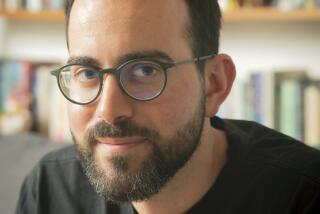Review: Neal Stephenson’s ‘Seveneves’ is moonstruck by nerdiness
- Share via
Neal Stephenson is amazing at beginnings and not so hot at endings, and his new novel, “Seveneves,” has a marvelous opening sentence: “The moon blew up without warning and for no apparent reason.” The reigning monarch of geek novelists since his 1992 cyberpunk sci-fi landmark, “Snow Crash,” Stephenson specializes in coming up with arresting premises, then teasing out how science and technology would affect their outcome — which can be hard for him to reconcile with the needs of fiction.
After the moon breaks into seven pieces on the first page of “Seveneves” (at an unspecified time in the near future), scientists figure out that, in about two years, it will turn into a hail of meteors that will extinguish life on Earth. The first two-thirds of the book is a disaster thriller that’s initially pushed upward like a rocket by that premise, then slowly settles into its own peculiar orbit.
The International Space Station becomes the centerpiece of a desperate attempt to keep the human race alive after the death of the planet: a “Cloud Ark” in space, with representatives of as much of the gene pool as possible. Naturally, there turn out to be major logistical problems with that idea, many of which occupy the bulk of the novel’s first 500 pages. Once politics gets into it, though — especially thanks to a U.S. president who acts like a sci-fi B-movie villain — natural catastrophes are augmented and amplified by human-made catastrophes.
When the dust settles, Earth is an uninhabitable fireball, and the space mission’s crew of 1,000-plus has only eight survivors. All of them are women, but one is post-menopausal; the others are the “seven Eves” of the title, whose task is to restart humanity from their new home in space. “What keeps us alive,” declares one of them, “isn’t bravery, or athleticism, or any of those other skills that were valuable in a caveman society. It’s our ability to master complex technological skills. It is our ability to be nerds. We need to breed nerds.”
Shortly thereafter, we get the delightful chapter heading “Five Thousand Years Later” and close to 300 frequently maddening pages’ worth of follow-up. The billions of descendants of the seven Eves have become seven ethnically and ideologically distinct tribes, in two coalitions, but have nonetheless managed to collaborate on technological marvels and are fixing up their former home planet to make it habitable again.
The idea that the descendants of seven survivors would not interbreed extensively over the course of the next 5,000 years — and, in fact, would remain visibly and culturally distinct while living and working alongside one another — is a tough sell. Nonetheless, they’ve got a shared culture based on “The Epic,” edited highlights of the surveillance footage from the journey documented in the novel’s first section, and they’ve somehow remained single-mindedly devoted to the cause of reconstructing Old Earth, which explains why several of the far-future characters know Morse code.
“Seveneves” is as hard as “hard science fiction” gets: cool bits of science and speculation about the future of technology, space and culture, with a plot and dialogue bolted on to make it more enjoyable to follow. That said, Stephenson’s speculation is fascinating. He’s got a lot to say about the physics of whips, glider transportation, military robotics, and everything else that can be crammed into his premise.
The most exciting section involves a mission to grab a comet and fly it back into the same orbit as the International Space Station; Stephenson is a gifted enough explainer and storyteller that every technical detail about “delta vee” and aerodynamics just makes it more white-knuckled. His vision of the culture of the future probably owes too much to the present, but his world building is impressively thorough and clever. And he can be pretty funny, in a nerdy way: The far-future section involves a wise old man named Dr. Hu as well as a young woman named Sonar Taxlaw, after the volume of the Encyclopaedia Britannica that she has memorized.
In effect, this means Stephenson’s conception of what novels do is fundamentally different from what they tend to do these days. If you are expecting a novel to revolve around, say, characters interacting with one another in compelling ways or meaning conveyed by narrative voice as well as by what happens, there is relatively little of that in “Seveneves.” The chief protagonists of the book’s near-future section, Dinah MacQuarrie and Ivy Xiao, are both hyper-competent polymaths with nearly identical voices and points of view. (The most memorable character in that section, TV-science popularizer Dubois Jerome Xavier “Doob” Harris, might as well be named Deil TeGrasse Nyson.)
By that novelistic metric, Stephenson’s Achilles’ heel, his ungainly way with endings, betrays him again, as it did in otherwise remarkable books such as “The Diamond Age” and “Cryptonomicon”: The final chapters of “Seveneves” depend on two different billion-to-one coincidences in short succession. Stephenson’s point, though, isn’t to offer a dramatically satisfying work as much as it is to propel the reader through a vivid demonstration of the necessity of nerddom.
Technological prowess, he suggests, may not save us, but its lack will certainly destroy us.
Wolk is the author of “Reading Comics: How Graphic Novels Work and What They Mean.”
Seveneves
A Novel
Neal Stephenson
William Morrow: 880 pp., $35
More to Read
Sign up for our Book Club newsletter
Get the latest news, events and more from the Los Angeles Times Book Club, and help us get L.A. reading and talking.
You may occasionally receive promotional content from the Los Angeles Times.










